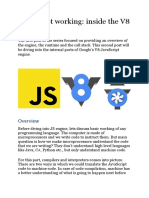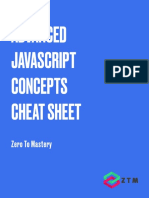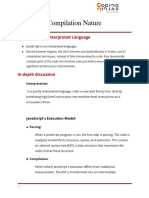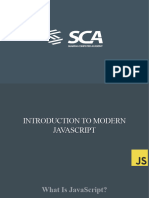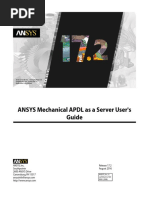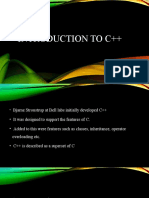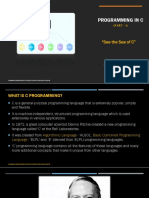10/29/21, 11:00 AM A Brief History of Google’s V8 JavaScript Engine
BLOG POST
A Brief History of Google’s V8
JavaScript Engine
September 28, 2017
Javascript has a reputation in developer circles as a terrible language. It’s
classless, loosely typed, and plagued by cross browser issues. Douglas
Crockford, author of JavaScript: The Good Parts, said “JavaScript contains some
of the best ideas ever put into a programming language and it contains some of
the worst ideas ever put into a programming language.” It was created in just 10
days in 1995, and not standardized by ECMA until almost 3 years later. Microsoft
initially decided not to implement the new standards, almost putting an end to
the language in its infancy.
The first JavaScript engine, codenamed SpiderMonkey, was built for Netscape
Navigator and was simply an interpreter that read and executed source code. At
the time, and for many years after, Javascript generally consisted of a few
functions written into the head of a webpage or a handful of inline events.
Interpreting the code as needed was satisfactory, if not fast.
https://www.mediacurrent.com/blog/brief-history-googles-v8-javascript-engine 1/6
�10/29/21, 11:00 AM A Brief History of Google’s V8 JavaScript Engine
We’ll skip the next 10 tumultuous years, to 2004, when Google introduced a new
application; Google Maps. For Javascript and developers everywhere it was a
game changer. A very, very slow game changer. Browsers bogged down as the
JavaScript engine simply plowed away at all that code.
There have been countless pages and bits dedicated to the explanation and
description of JavaScript engines, see the 'Learn More" section at the end of this
post for examples. And it’s a topic that even most professional JS developers
aren’t quite clear on. So I’d like to provide you with a very brief overview of
engines, especially the shiniest toy in the box right now, V8.
Most Javascript engines process code in a few steps. First, lexical analysis breaks
the code into tokens to identify their meaning. The tokens are then analyzed by a
parser and built into a syntax tree in an intermediate language, like bytecode.
Finally, the JIT compilers kick in and execute the code.
In 2008 Google introduced its souped-up version of the engine, V8.
The V8 engine uses several threads. The main thread does what you would
expect: it fetches your code, compiles it, and executes it. There's also a separate
thread for compiling, so that the main thread can keep executing while this one
is optimizing the code, and a profiler thread that will tell the runtime in which
methods we spend a lot of time, so that the compilers can optimize them. There
are also a few threads to handle garbage collection and dead code elimination.
V8 has 2 compilers, Full-Codegen and Crankshaft. Full-Codegen parses
JavaScript directly to machine code, without an intermediary language, allowing
it to begin execution sooner. A JIT compiler called Crankshaft produces
optimized code for hot methods. This means that in the same V8 program,
different levels of optimized code coexist at the same time.
Crankshaft is where the speed really comes from. While Full-Codgen is running,
a runtime profiler identifies “hot code,” code that’s executed many times. At this
point, the current thread stops executing your code and passes it to Crankshaft.
https://www.mediacurrent.com/blog/brief-history-googles-v8-javascript-engine 2/6
�10/29/21, 11:00 AM A Brief History of Google’s V8 JavaScript Engine
The base here for all optimizations is inline-caching, a technique pioneered by
Smaltalk. It consists of patching the code with better code instantly.
The parsed JS is first compiled to a high-level representation called Hydrogen,
where most optimizations are done. This is where type-specialization happens.
The type-specialization removes what JavaScript calls boxing and unboxing
operations. So, for example, if your script often runs a function on a set of
integers, it avoids sorting through all the necessary steps to parse strings and
floats, and saves the needed steps to parse your integers so it doesn’t have to
run them again.
Because JS is non-typed, there is no guarantee that the specialized generated
code will continue to work. Your function could be called on to work with strings,
or doubles. This code now has to be de-optimized, pulled out of the running
thread and replaced with the original runtime code. This is accomplished with a
technique called on-stack replacement (OSR). OSR is the mechanism that
preserves the semantics of the current stack frame while switching between
optimized and unoptimized code. Using OSR, when your function arguments
switch types, the optimized code is pulled and your thread is dumped back into
the original Hydrogen generated thread to be recompiled.
Crankshafts final job is to lower the representation to a level called Lithium,
which is architecture specific. Lithium is the representation that is finally
translated into machine code. Here, we see OSR again. The code has been
running in your browser or application while all these steps were going on, and
now that we have a fully compiled and optimized version we can switch to the
optimized version in the middle of the execution.
Simply running the two compilers concurrently boosts performance by 27%. And
it’s not done. Every six weeks the V8 team releases a new branch. On September
11th, the team announced version 6.2, which will be released with Chrome 62 in a
few weeks. This next version includes what the team calls “all sorts of developer-
facing goodies” and performance optimizations. You can read about the next
release HERE.
https://www.mediacurrent.com/blog/brief-history-googles-v8-javascript-engine 3/6
�10/29/21, 11:00 AM A Brief History of Google’s V8 JavaScript Engine
Learn more:
Chrome V8 developer channel: https://developers.google.com/v8/
Red Hat Developer Program: Javascript Engine & Performance Comparison (V8,
Chakra, Chakra
Core): https://developers.redhat.com/blog/2016/05/31/javascript-engine-
performance-comparison-v8-charkra-chakra-core-2/
Lars Bak: V8: an open source JavaScript engine:
https://www.youtube.com/watch?v=hWhMKalEicY
Daniel Clifford: Google I/O 2012 - Breaking the JavaScript Speed Limit with
V8: https://www.youtube.com/watch?v=UJPdhx5zTaw&t=48s
Additional Resources
Next-Level Drupal: Applied Progressive Decoupling with Javascript | Video
Decoupled Blocks with Drupal 8 and Javascript | Blog
Related Insights
0 Comments Mediacurrent 🔒 Disqus' Privacy Policy Рифат Чолаков
Favorite t Tweet f Share Sort by Best
Start the discussion…
Be the first to comment.
✉ Subscribe d Add Disqus to your siteAdd DisqusAdd ⚠ Do Not Sell My Data
https://www.mediacurrent.com/blog/brief-history-googles-v8-javascript-engine 4/6
�10/29/21, 11:00 AM A Brief History of Google’s V8 JavaScript Engine
678-580-1690
START A PROJECT
Our Work
Drupal
Drupal Community
Who We Are
Our Security Approach
We're Hiring
Events
Contact Us
Sign-up for an occasional drop of useful tips.
https://www.mediacurrent.com/blog/brief-history-googles-v8-javascript-engine 5/6
�10/29/21, 11:00 AM A Brief History of Google’s V8 JavaScript Engine
Enter your email address
Legal Privacy Accessibility
© 2007 - 2021 Mediacurrent Interactive Solutions LLC - All Rights Reserved
https://www.mediacurrent.com/blog/brief-history-googles-v8-javascript-engine 6/6
